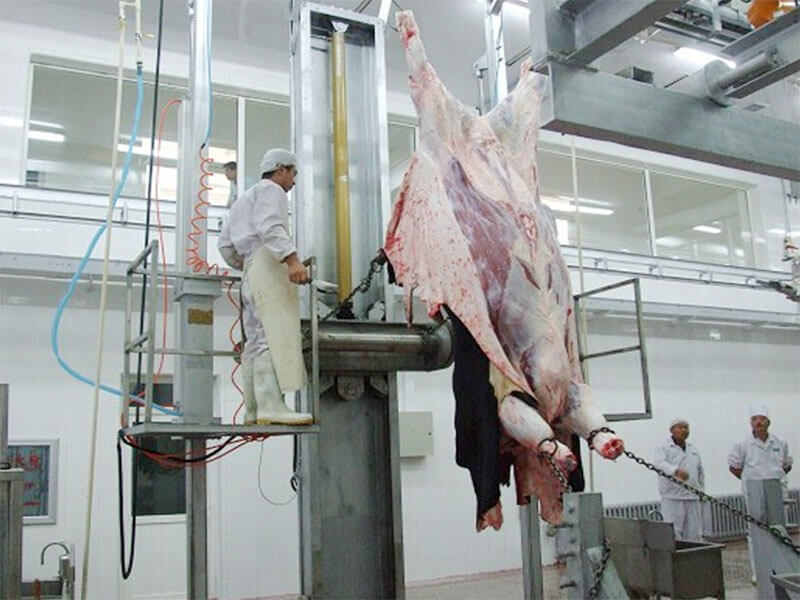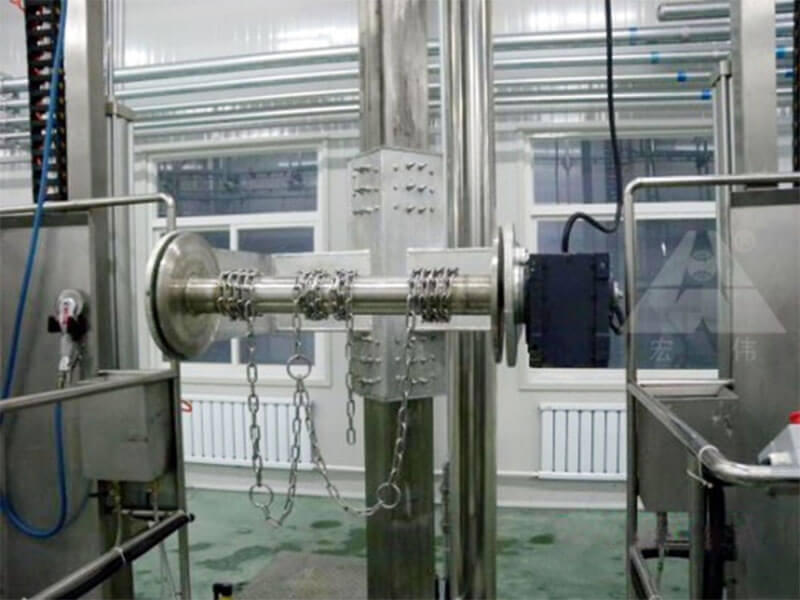
Following the initial stages of the Cattle Abattoir Slaughter Line Process, which include Rail Changing & Pre-Skinning, the subsequent step of dehiding or skinning holds significant importance within a cattle or cow abattoir slaughter line.
- The pre-skinned/pre-peeled cattle/cow is automatically conveyed to the dehiding station. Utilizing the corbel chain, the two front legs of the cattle or cow are securely fastened to the corbel bracket.
- The dehiding machine for cattle/cow employs a hydraulic mechanism to elevate the skinning roller to the level of the cow’s hind legs. The pre-peeled/pre-skinned cowhide is then clamped with the cowhide clip and pulled from the hind legs towards the head. Throughout the mechanical peeling process, operators positioned on both sides stand on a single-column pneumatic lifting platform, carrying out any necessary repairs until the head skin is completely removed.
3. Once the cowhide has been successfully detached, the peeling roller initiates a reverse motion, autonomously depositing the cowhide into the cowhide air delivery tank via the cowhide automatic unfastening chain.
4. Subsequently, the pneumatic gate is closed, and compressed air is introduced into the cowhide air delivery tank, facilitating the transportation of the cowhide through the air delivery pipe to the cowhide temporary storage room.
The next phase in the process is Cattle Carcass Processing.
Dehiding is a critical step in the cattle abattoir slaughter line as it involves the removal of the animal’s skin, which is essential for further processing and value-added products. This process ensures the hygienic preparation of cattle carcasses for subsequent stages such as carcass inspection, meat cutting, and packaging.
The use of automated dehiding machines enhances efficiency, consistency, and worker safety. These machines are designed to streamline the skinning process, reducing manual labor and increasing productivity.
It is crucial to maintain high standards of hygiene during dehiding to prevent contamination and ensure the production of safe and quality meat products. Regular cleaning and sanitization of the dehiding equipment, as well as adherence to food safety regulations, are essential practices within the abattoir environment.
Quality control measures, such as inspecting the cowhide for any defects or irregularities, are often performed during the dehiding process. Any issues identified can be addressed promptly to maintain the integrity of the final product.
Following dehiding, the cattle carcasses proceed to the next stage of the slaughter line, which involves further processing for beef carcass and preparation for the production of various meat products.
In conclusion, the dehiding process in a cattle abattoir plays a vital role in preparing the animal carcasses for subsequent processing. Automation, hygiene, and quality control measures are key factors in ensuring efficient and safe dehiding operations, contributing to the overall production of high-quality meat products.
If you want more information, please contact us by email or WhatsApp. You can add our WhatsApp by scanning the QR code on the right.



How much is this machine